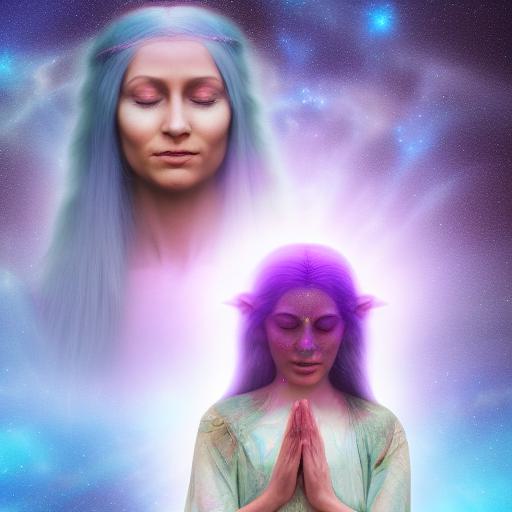How to write this prompt?
Here’s a breakdown of the various elements in the prompt and how they impact the image being generated:
- Description of the scene: The prompt starts with a detailed description of the setting, which is an aerial view of a woman in psychedelic art sitting on a rock in space, surrounded by stars and planets. This helps the AI understand the overall context and theme of the image.
- The woman: The prompt then describes the woman as an elven spirit, meditating with a purple flower in her hand. This provides the AI with information about the subject of the image and her demeanor.
- Lighting: The prompt mentions the lighting as ambient, with crepuscular rays creating a mystical effect. This helps the AI understand the mood of the scene and how it should be lit.
- The woman’s dress: The prompt describes the woman’s dress as a mix of blue and purple, blending with the space background. This helps the AI create a cohesive color scheme for the image.
- Artistic style: The prompt states that the artwork is a digital 2D fantasy art, inspired by Amanda Sage’s style, rendered with Lumen reflections, giving it an ultra-realistic look. This provides the AI with information about the artistic style that should be used to create the image, as well as the specific techniques that should be employed.
All of these elements work together to create a detailed, specific prompt that guides the AI towards creating a particular type of image. By providing information about the setting, subject, lighting, color scheme, and artistic style, the prompt ensures that the generated image matches the desired aesthetic and theme.
What is the Lumen reflection technique mentioned in the prompt?
Lumen is a real-time global illumination system developed by Unreal Engine. It simulates indirect lighting and reflections, allowing for more realistic and immersive visuals in digital art and video games. The Lumen reflection technique mentioned in the prompt refers to the use of this system to create realistic lighting and reflections in the generated image.
How to create a cohesive color scheme for a digital art image like the one described in the prompt?
There are many ways to create a cohesive color scheme for a digital art image, but one approach is to use a color wheel or palette generator tool to choose colors that complement each other. The prompt specifically mentions a mix of blue and purple for the woman’s dress, so the AI may have used a similar tool or algorithm to select other colors for the image that would blend well with the space background and psychedelic theme.
Why is Amanda Sage’s artistic style mentioned in the prompt?
Amanda Sage is a well-known artist who specializes in visionary and psychedelic art. By mentioning her style in the prompt, the author is providing the AI with a specific reference point and aesthetic to emulate. This helps ensure that the generated image is consistent with the desired style and theme, and can also help give the image a unique and recognizable look.
Can AI art generation prompts be used for commercial purposes?
Yes, AI art generation prompts can be used for commercial purposes. In fact, many businesses and industries have started to explore the potential of AI-generated art for various applications, such as advertising, product design, and interior decoration. AI-generated art can be used to create unique and eye-catching visuals that stand out from traditional art forms. It can also be produced quickly and at a lower cost compared to hiring human artists. However, it is important to note that the use of AI-generated art for commercial purposes raises ethical and legal questions, such as ownership, attribution, and copyright.
Can AI-generated art be improved or edited by humans?
Yes, AI-generated art can be improved or edited by humans. While AI algorithms can create impressive and complex images, they still have limitations and may not always produce the desired results. Humans can provide feedback and make adjustments to the generated art to enhance its quality and achieve a specific aesthetic or theme. Additionally, humans can also incorporate their own creative input and style into the AI-generated art, resulting in a unique hybrid of human and AI creativity. However, it is important to note that editing or modifying AI-generated art may also raise ethical questions regarding ownership and authenticity.
Looking to add some cutting-edge creativity to your designs? Look no further than Visual Paradigm Online! With our innovative design tools, you can seamlessly incorporate stunning AI-generated art into your graphics with just a few clicks. Our user-friendly interface and extensive range of design templates and assets make experimentation a breeze, so you can explore countless styles and layouts until you find the perfect combination for your project. Elevate your designs to the next level with Visual Paradigm Online today!


